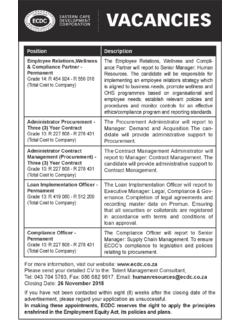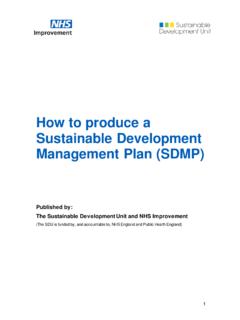Transcription of GUIDELINES FOR COSTING AND BUDGETING FOR …
1 GUIDELINES FOR COSTING AND. BUDGETING FOR COMPENSATION. OF EMPLOYEES. FOR THE PREPARATION OF EXPENDITURE ESTIMATES FOR THE. 2019 MEDIUM TERM EXPENDITURE FRAMEWORK (MTEF). National Treasury June 2018 . 1 INTRODUCTION. 13 January 2016 Cabinet approved compensation baseline reductions of R10 billion in 2017/18. and R15 billion in 2018 /19. These reductions were distributed across all national and provincial departments, with a larger portion of the reduction made to national votes, as directed by Cabinet. Further reductions amounting to R471 million in 2018 /19 and R497 million in 2019/20. were effected at National.
2 Institutions are expected to continue to budget for compensation of employees within the set ceilings. Departments are expected to adhere to the set ceilings during the 2019 MTEF. They will be expected to summarize the content of the Human Resource Budget Plans (HRBP) indicating how the institutions will manage their workforces within the allocated compensation budget ceilings. Institutions are expected to manage and monitor implementation of set ceilings and headcount numbers with the view to identify the sources of cost pressures so that corrective measures can be taken, with the support of Treasuries.
3 2 Wage Agreement A new multi-year wage agreement was signed in June 2018 . The agreement is implemented with effect from 1 April 2018 and allows for the adjustment and improvements to conditions of service for employees for the period 2018 /19 to 2020/21. The wage adjustments are aligned to the CPI inflation projections detailed below. CPI inflation projections CPI inflation projections are as follows: - 2018 /19: - 2019/20: - 2020/21: - 2020/22: Key cost drivers of the wage agreement over the 2019 MTEF have been revised. Cost of living adjustments, housing, medical allowance increases and progression rates are detailed below.
4 Cost of living adjustments The cost-of-living adjustment in 2018 /19 is as follows: for salary levels 1-7. for salary levels 8-10. for salary levels 11-12. The cost-of-living adjustment in 2019/20 is as follows: (CPI + 1%) for salary levels 1-7. (CPI + ) for salary levels 8-10. 2 | COE Technical GUIDELINES : 2019 MTEF. (CPI) for salary levels 11-12. The cost-of-living adjustment in 2020/21 is as follows: (CPI + 1%) for salary levels 1-7. (CPI + ) for salary levels 8-10. (CPI) for salary levels 11-12. The cost-of-living adjustment in 2021/22 is as follows (not covered by the 2018 wage agreement but based on the provisions of the last two years of the agreement): (CPI + 1%) for salary levels 1-7.
5 (CPI + ) for salary levels 8-10. (CPI) for salary levels 11-12. Medical Allowance The actual increase of medical allowance is for 2018 calendar year. Medical allowances projections are based on Medical Price Index (MPI), which is normally CPI. + The following are the projections used in the HRBP for BUDGETING purpose. (CPI + ) in 2019/20. (CPI + ) in 2020/21. (CPI + ) in 2021/22. Housing Allowance An increase of Housing Allowance by CPI each year. R1346 in 2018 /19. R1418 in 2019/20. R1495 in 2020/21. R1578 in 2021/22. Parties to the negotiations have agreed to delink payment of housing allowance of spouses.
6 Therefore, Clause (b) of PSCBC Resolution 2 of 2004 no longer applies. Departments are required to delink housing allowance as follows: Spouses of employees on salary level 1-5 with effect from 1 September 2018 ;. and Spouses of employees on salary level 6-12 with effect from 1 September 2019. Departments are requested to carefully budget for costs of extending the housing allowance to qualifying spouses of public servants over the MTEF. 3 | COE Technical GUIDELINES : 2019 MTEF. Escalation factors for SMS and MMS. Escalation factors applicable to Middle Management Services (MMS) and Senior Management Services (SMS) are detailed in Tables 3 and 4 below.
7 Progression rates Parties to the negotiations have agreed to the equalisation of pay progression across the public service at per cent per annum. Equalisation is to be implemented incrementally for educators employed in terms of the Employment of Educators Act 76 of 1998 (as amended); TVET lecturers employed in terms of the Public Service Act 103 of 1994 (as amended); and the Educators appointed in terms of the Correctional Services Act 111 of 1998 (as amended). Implementation should be as follows: Increasing of the progression rate from per cent per annum to per cent per annum with effect from 1 July 2018 ( an across the board adjustment of per cent).
8 Increasing the progression rate from per cent per annum to per cent per annum with effect from 1 July 2019 ( an across the board adjustment of per cent). Equalisation for employees employed in terms of the Police Service Act 68 of 1995 (as amended) should be implemented as follows: Increasing progression from an average of per cent per annum to per cent per annum with effect from 1 July 2019 ( an across the board adjustment of per cent). 3 Funding of Wage Agreement Costs No additional funding will be made available to directly fund the costs associated with the wage agreement. Departments are expected to fund the wage agreement costs from within the current compensation budget baselines.
9 Departments are expected to thoroughly explore strategies available for headcount management as provided in various circulars and policy documents issued by the DPSA. Where further guidance is required, departments are urged to consult the DPSA directly. Funding will, however, be made available from the fiscus to finance costs associated with implementation of headcount management strategies. Headcount management tools readily available that may require funding from the centre include Employee Initiated Severance Package (EISP) and Early retirement without a pension penalty ( with no scaling down).
10 Departments will be expected to submit proposals for implementation of such headcount management strategies directly to the DPSA for assessment, further guidance and/or approval. Once approval has been obtained from the DPSA, department may apply to the National Treasury for central funding of costs associated with such exits. These applications will be assessed during the course of the budget process together with other competing demands. 4 | COE Technical GUIDELINES : 2019 MTEF. The DPSA will issue comprehensive guidance on headcount management and exit strategies. 4 Headcount Management: Departments are expected to manage their headcount within the allocated ceilings.















